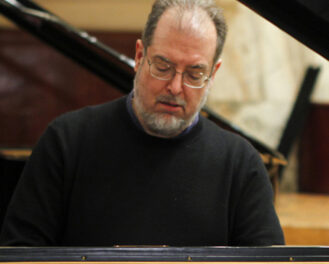The celebratory programming for the 100th anniversary of the birth of American composer Samuel Barber (1910-81) started last night on the East Campus of Duke University and continued in Memorial Hall on the University of North Carolina campus. UNC Symphony Orchestra Music Director Tonu Kalam opened the concert with the seldom programmed Piano Concerto, Op. 38 (1962), with UNC alumna Molly Morkoski (Class of 1994) as his virtuosic soloist. Kalam fields the largest all-student orchestra CVNC knows of in this state. There were about 36 violins, 14 violas, 18 cellos, and 7 double basses. Brass, percussion, and woodwinds were present in the usual numbers. The large string section paid dividends in the gorgeous, plush Brahms symphony which ended the evening.
Kalam spoke from the stage about the Barber centennial and about the Piano Concerto, which he said would join with those of Bartók, Prokofiev, and Rachmaninoff as among the best concertos for keyboard from the twentieth century. He said soloist Morkoski had been a concerto winner as an undergraduate, having played a Liszt concerto, and had gone on to a successful career in music combining teaching while still concertizing with a focus on contemporary music.
Barber’s Piano Concerto represents the acme of the composer’s reputation. It was commissioned by publisher G. Shirmer on the occasion of the firm’s 100th anniversary in 1961. Barber composed the piece with the virtuoso technique of John Browning in mind. Browning gave the premiere September 24, 1961, with the Boston Symphony Orchestra conducted by Erich Leinsdorf. This description of the piece is drawn from Kalam’s program note and Richard Whitehouse’s CD notes for the Naxos recording. An imperious cadenza passage for solo piano opens the work, leading to “brusque orchestral chords presaging the agitated first theme.” The scoring is “prodigiously demanding of both the soloist and the orchestra.” The theme is “developed in a capricious dialogue between piano and woodwind” before the flute and horn provide a short codetta. A solo oboe introduces the “plaintive second theme” elaborated by expressive strings before the piano enters. Its rippling ostinato motion leads a drive to the climax capped by a brilliant piano cadenza followed by a brief coda. Highlights of the second movement, Canzone, are gently undulating strings supporting a wistful melodic idea in solo woodwinds. The piano takes up the melody and a “bitter-sweet dialogue ensues” before the keyboard expands the idea into “an intricate arabesque.” There are plenty of fireworks for the pianist, the brass and the percussion in the finale, which resembles a fiercely energetic free rondo with two reoccurring musical thoughts.
Morkoski played the Piano Concerto using a score but it was hardly a hindrance to her intense virtuosity. Her dynamic range was tremendous, from perfectly focused fff notes to hushed, quiet passages. She articulated the fastest passages unerringly. Her cadenzas were breath-taking. Kalam led a superb, idiomatic interpretation with good orchestral balance and attentive accompaniment. The delicate opening of the second movement was especially well done with fine solos from flutist Gracie Murchison, harpist Caroline Scism, and oboist Kiran Bhardwaj.
What a pleasure it was to hear the Second Symphony in D, Op. 73 of Johannes Brahms (1833-97) given by a really large orchestra awash with lots of well-played strings! Many of the symphony’s themes begin in the cellos, and Kalam’s cellos really dug into them. The violins and violas reveled in Brahms’ delicious melodies. A few intonation slips detracted but little from the composer’s bucolic writing for horns. Kiran Bhardwaj’s second movement oboe solo was superbly phrased. Clarinets and other woodwinds made strong contributions. The crucial rasps by the three trombones came off just right in the last movement. Principal horn Daniel Hammond and other principal players earned their acknowledgements by Kalam.












